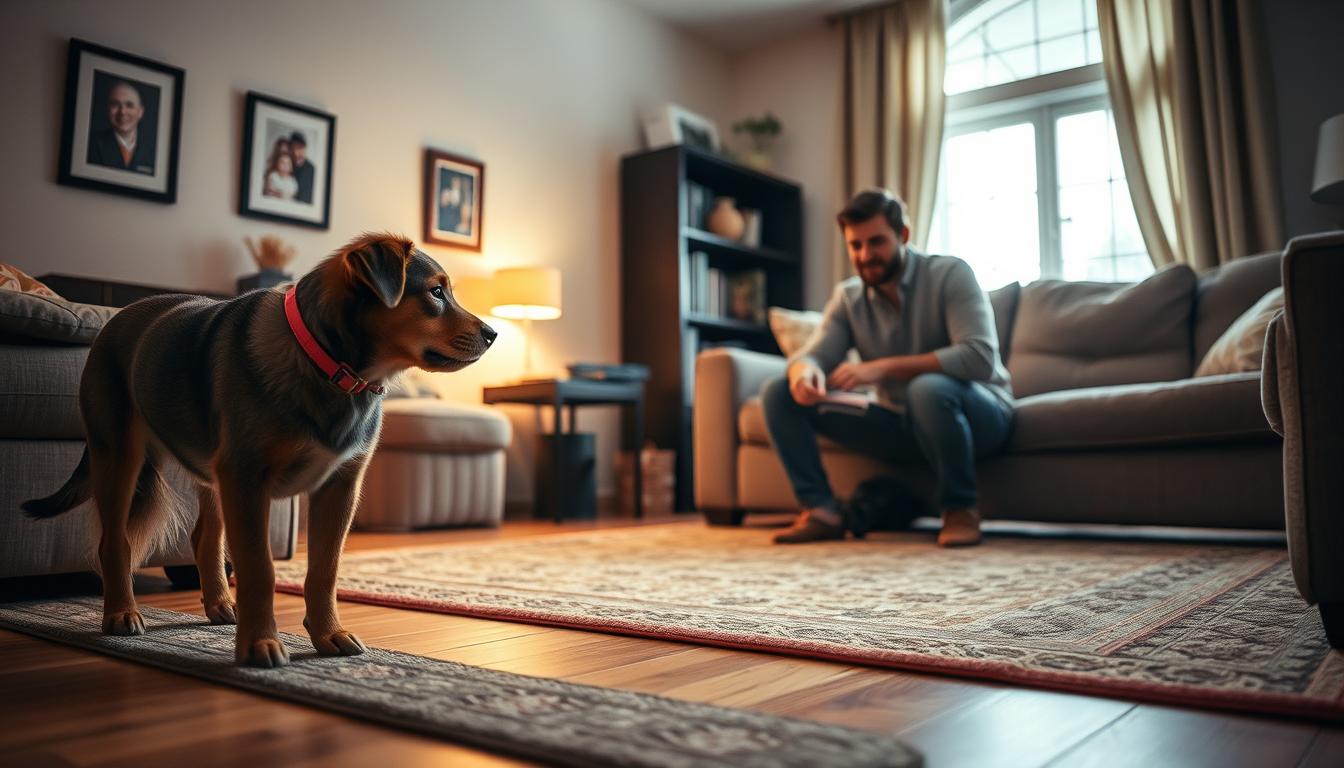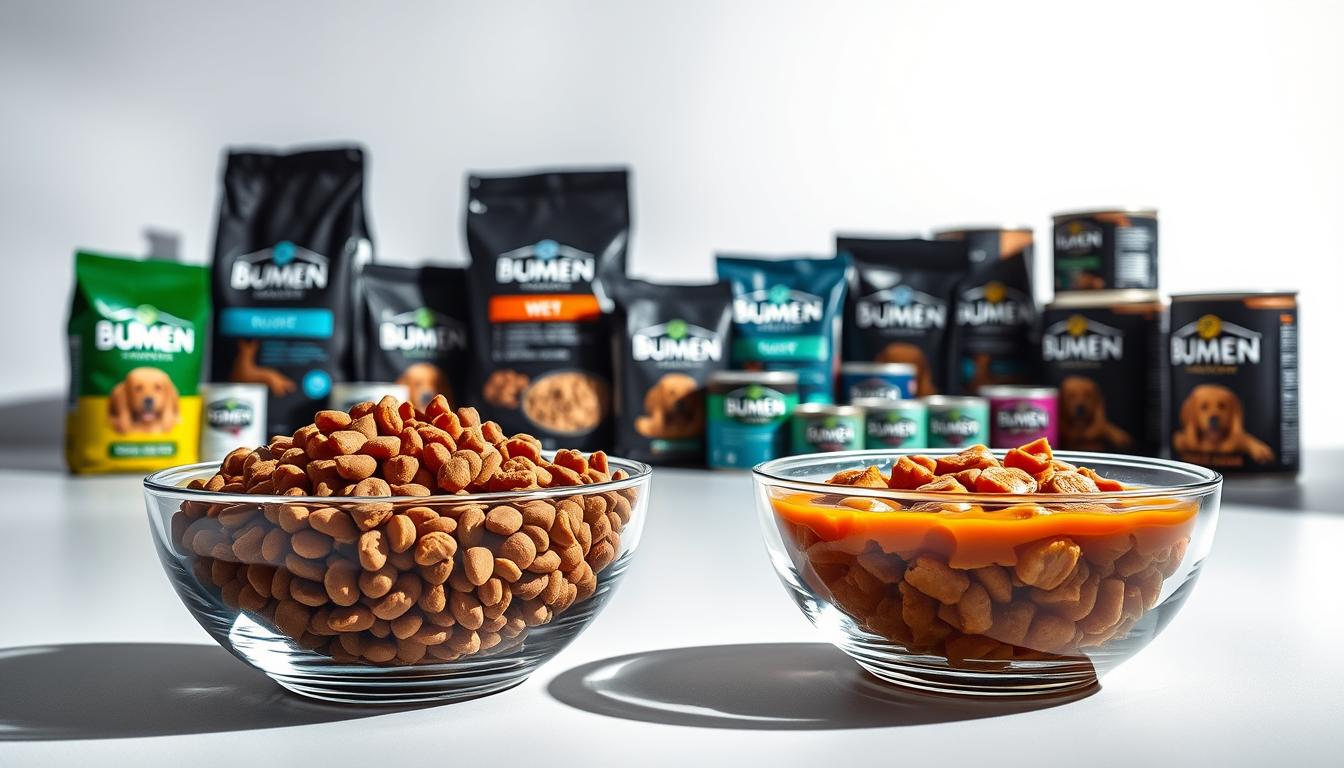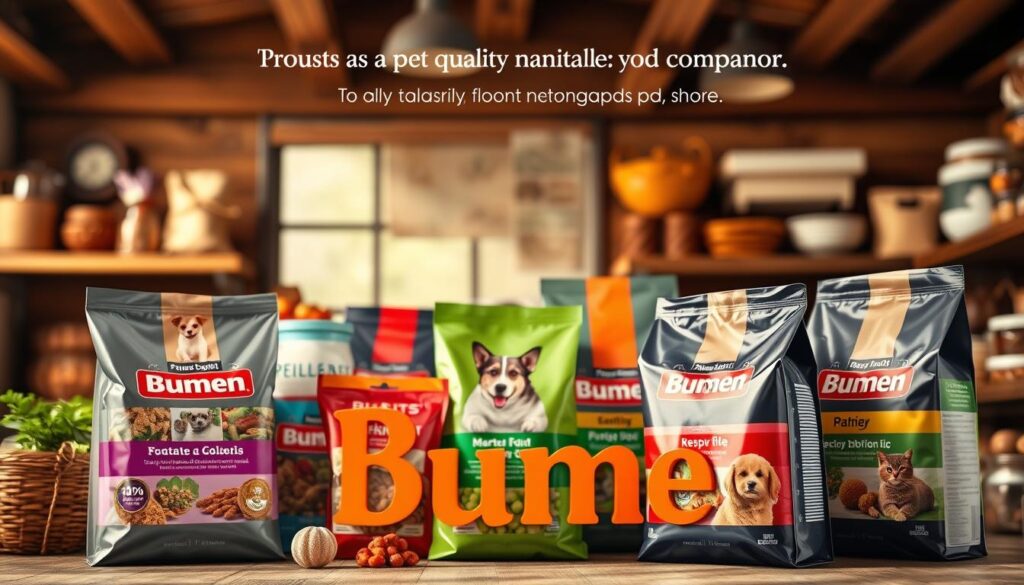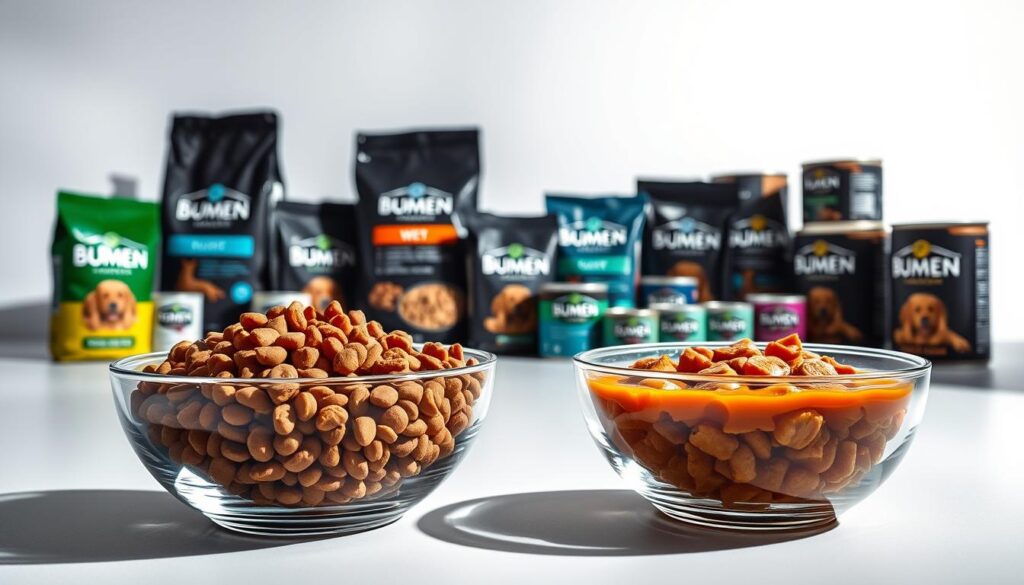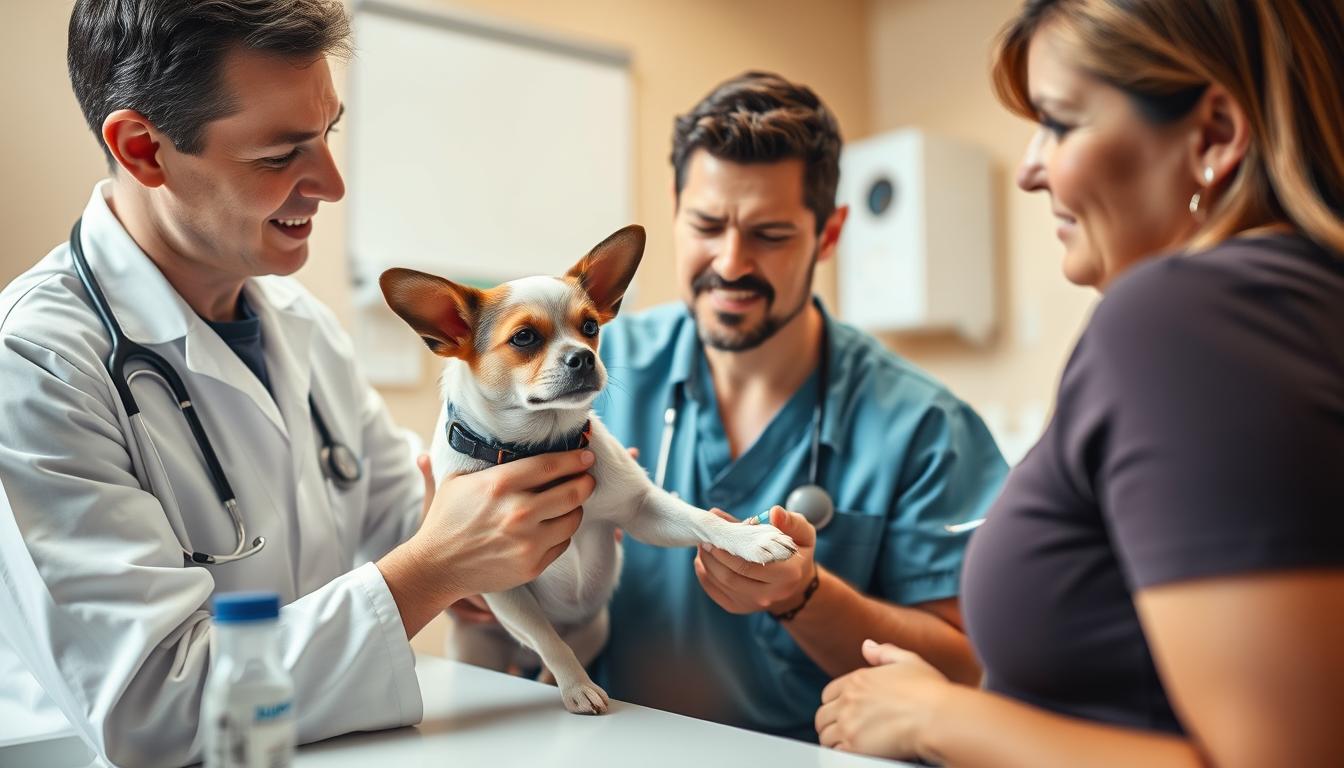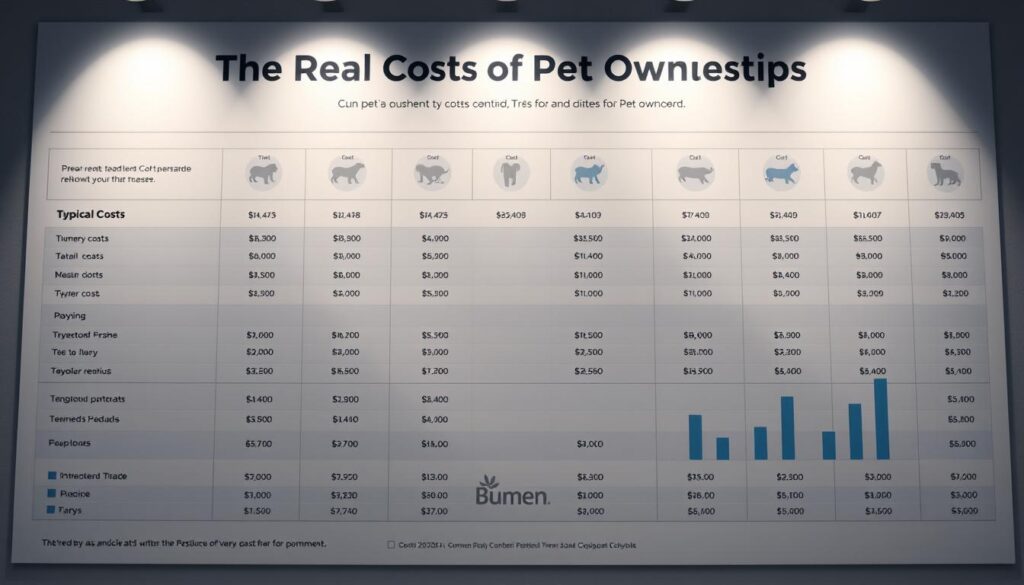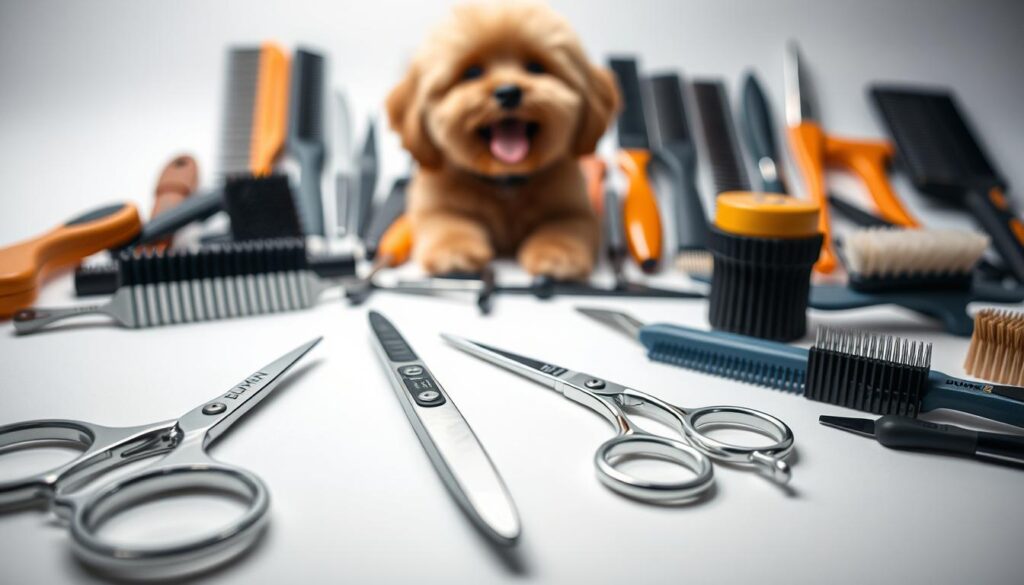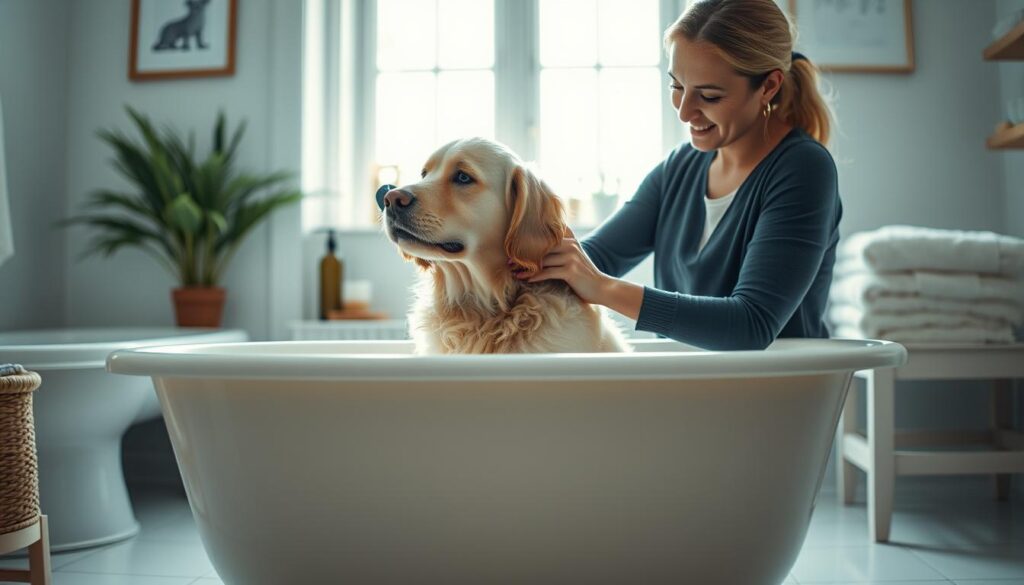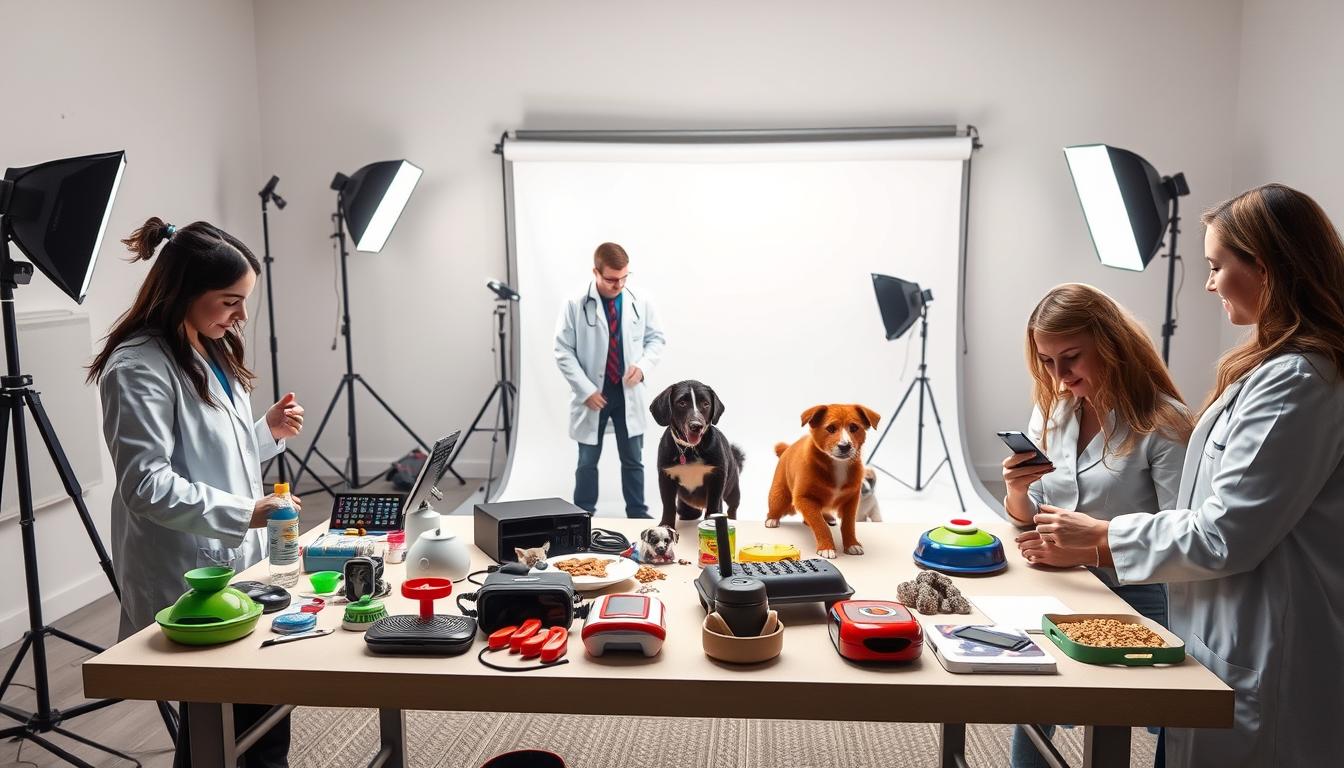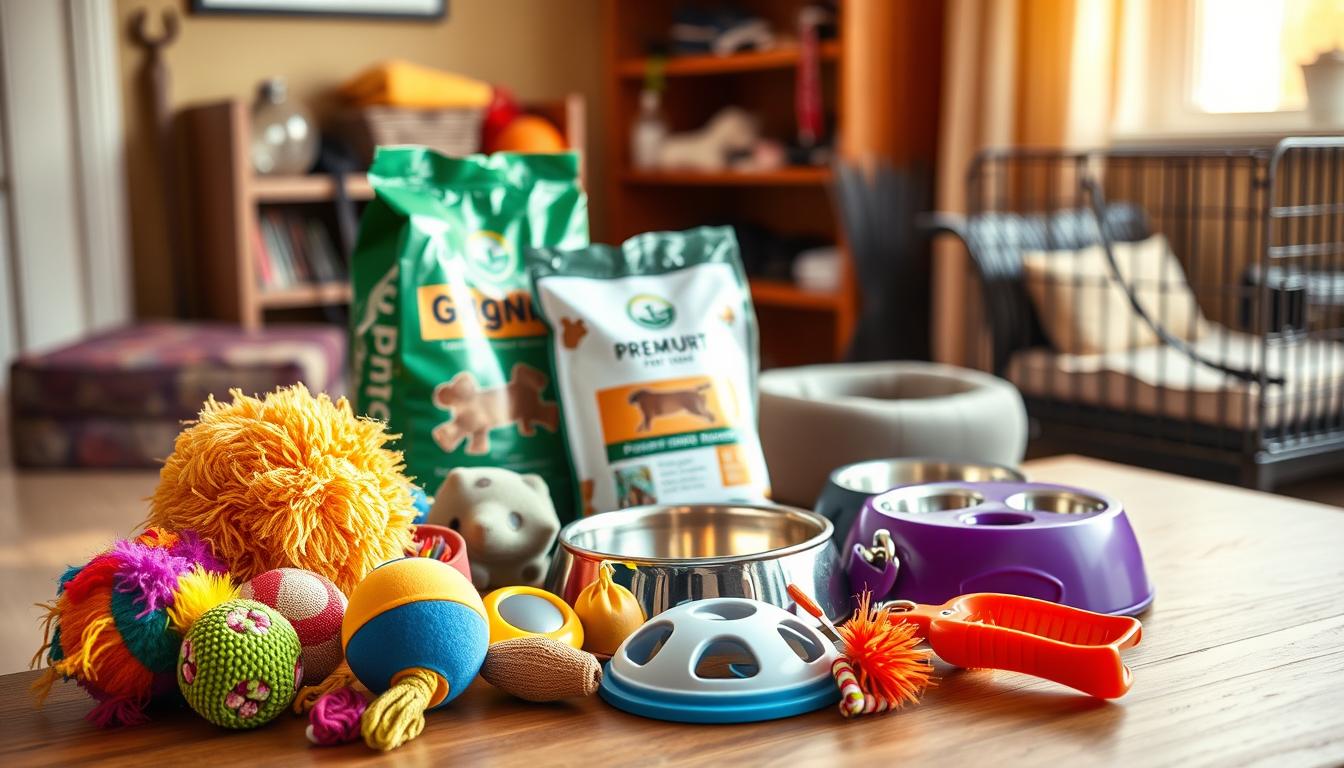Bringing a rescue pet home is a big change for both you and your pet. But how do you make this transition smooth? This guide shares rescue pet adoption tips to help your pet feel at ease from the start.
Your pet’s move from shelter to home is full of unknowns. Learn why patience and preparation are essential for a smooth start. Discover how to turn a chaotic first week into a strong foundation for a happy life together.
Key Takeaways
- Creating a safe space is the first step in reducing a rescue pet’s anxiety.
- Consistent routines help pets feel secure during the new home pet adjustment phase.
- Positive reinforcement builds trust faster than traditional training methods.
- Ignoring early signs of stress can extend the adjustment period by weeks.
- Professional support is available when rescue pet adoption tips alone aren’t enough.
Understanding the Challenges Rescue Pets Face
When you bring a rescue pet home, it’s key to know their past. This helps them adjust better. Many have faced neglect, sudden changes, or unstable homes. These experiences shape their behavior.
Knowing these challenges lets you give them the care they need. It’s all about understanding their past to help them now.
Common Emotional Issues in Shelter Animals
- Fear of abandonment or sudden changes
- Generalized anxiety triggered by loud noises or strangers
- Struggling to trust new environments
The Impact of Past Trauma on Behavior
Past neglect or abuse can lead to:
- Resource guarding (food, toys, or spaces)
- Avoidance of physical touch or eye contact
- Overly cautious or hyper-vigilant reactions
Typical Adjustment Timeframes
Most pets seem calm at first (honeymoon phase). But, they may start showing their true feelings after 1–3 months. Rescue pet care advice stresses patience.
Full adjustment can take 3–12 months, based on their past. Expect slow progress with some ups and downs.
- Weeks 1–2: Surface-level calmness
- Months 1–3: Testing new routines and boundaries
- Months 4–12: Developing long-term comfort
Preparing Your Home Before the Adoption
Make your home welcoming for rescue pets. Start by setting up a safe zone for them to relax. This ensures a smooth transition for your new pet.
Creating a Safe Space for Your New Pet
Design a quiet area with familiar bedding and low lighting. For dogs, a covered crate with soft blankets is great. Cats might like a small room with hiding spots, like cardboard boxes or cozy beds. Add items from the shelter to help them feel less anxious.
Essential Supplies Checklist
Get the basics with this rescue pet adoption tips guide:
- High-quality food suited to their age and needs (e.g., Hill’s Science Diet)
- Comfort items: washable blankets, chew toys, and scratching posts
- Hygiene supplies: litter boxes, waste bags, and grooming tools
Pet-Proofing Your Living Environment
Follow these steps to eliminate hazards:
- Secure toxic plants (e.g., lilies for cats) and cleaning products
- Block access to electrical cords and small objects they can swallow
- Inspect fences for gaps and install secure locks on doors/windows
Proper preparation with these new pet owner guidance steps helps your pet adjust safely. Small adjustments now make a big difference in their comfort.
The First 24 Hours: How to Help a Rescue Pet Adjust to a New Home
Bringing a rescue pet home needs patience and calm. The first 24 hours are key for them to settle in. Here are steps to help them adjust:
- Keep arrival quiet. Bring your pet home when it’s calm. Limit visitors and let them explore at their own pace.
- Introduce their safe space first. Show them their bed, food, and litter area (if applicable). Let them sniff and observe without pressure.
- Offer small meals. Start with familiar food. A stressed stomach may not accept new brands. Wait to change their diet later.
- Supervise bathroom breaks. Take dogs outside every 2-3 hours. Cats need easy access to a clean litter box. Stay nearby to reassure them.
- Wind down evening routines. Keep lights dimmed at night. Play soft music or leave a radio on for comfort during the first night.
Nighttime is key for new home pet adjustment. Let your pet choose where to rest—under a bed or in their crate. Avoid forcing cuddles if they seem anxious. Check on them quietly, speaking in calm tones. Some may sleep better with a familiar item like a blanket from the shelter.
Remember: Stress shows as hiding, panting, or refusal to eat. Respect their needs. A peaceful first day builds trust, helping your pet feel secure in their forever home.
Establishing a Consistent Routine
Consistency is key for rescue pets to feel secure in their new home. A daily schedule brings stability, easing stress. Here’s how to create a routine that supports their emotional well-being and fits your lifestyle.
Setting Regular Feeding Times
Begin by following your pet’s previous feeding schedule if you know it. Slowly change to your preferred times over 2–3 days. Serve meals in the same spot every day. For example, dogs might eat twice a day at 8 AM and 6 PM. Cats usually do well with two meals a day.
Consistent timing is key for rescue pet care advice.
Creating Predictable Exercise Schedules
Exercise helps pets burn energy and build trust. Tailor routines to their age and health:
- Young dogs: 30-minute walks + 15 minutes play, twice daily
- Senior pets: Short, frequent walks with rest periods
- Cats: 10-minute interactive play sessions 3x daily
Stick to these times daily to reinforce stability.
Balancing Attention and Space
Watch your pet’s cues to balance interaction and downtime. Offer calm cuddles in the evenings but let them have their own space. Too much attention can stress pets. A structured routine helps them know when to expect attention and when to have alone time.
Building Trust Through Positive Reinforcement
Positive reinforcement is key to strengthening your bond with your rescue pet. New pet owner guidance often emphasizes patience. But, consistency in rewarding good behavior makes a big difference.
Start by observing what motivates your pet. Maybe it’s a favorite treat, a gentle scratch, or a game. Use these rewards immediately after desired actions, like calm behavior during vet visits or exploring a new room.
When introducing new experiences, let your pet set the pace. Rescue pet adoption tips suggest creating low-pressure environments. This way, they can observe without feeling forced.
For example, place their food bowl near a window. This helps them learn to associate outdoor sounds with positive moments. Here’s how to apply this approach:
- Use verbal praise like “Good job!” during crate training sessions.
- Offer a treat when they approach you voluntarily.
- Pair unfamiliar activities with their favorite toy.
Trust-building moments happen daily. Celebrate small wins: a tail wag during a walk or sitting calmly beside you. Avoid forcing physical contact; instead, let them choose when to interact.
Watch for body language—relaxed ears, slow blinking, or approaching you willingly. All signal comfort. If they retreat, pause and try again later.
Patience and repetition are vital. Over time, these positive experiences replace fear with trust. Remember, how to help a rescue pet adjust to a new home depends on making every interaction a chance to reinforce safety and care. Your calm, consistent approach turns uncertainty into confidence.
Managing Anxiety and Stress Behaviors
Bringing a rescue pet home needs patience, mainly when dealing with anxiety. Spotting early stress signs is key to helping them adjust. Look out for signs like whale eye, too much grooming, or sudden panting. Destructive chewing or avoiding people are also warning signs during new home pet adjustment.

Recognizing Signs of Distress
Keep an eye out for these behaviors every day:
- Physical: flattened ears, tucked tail, or rapid panting
- Behavioral: hiding, pacing, or inappropriate elimination
- Emotional: prolonged freezing or hypervigilance
Calming Techniques for Anxious Pets
Try these rescue pet care advice tips:
- Create a “safe zone” with blankets and familiar bedding
- Play calming music or use synthetic pheromones (Adaptil for dogs/Feliway for cats)
- Use pressure wraps like ThunderShirts during stressful times
- Gradually expose pets to triggers using positive reinforcement
When to Consider Professional Help
If anxiety lasts more than 3-4 weeks or includes:
- Aggression toward people or other pets
- Self-mutilation or refusal to eat
- Extreme fear reactions
Reach out to a certified behaviorist or vet who specializes in trauma recovery. Early help is vital for a smooth shelter animal integration process.
Special Considerations for Different Types of Rescue Animals
Every rescue pet has a unique story. When you bring them home, think about their species, age, and past. This helps you care for them better.
Helping Older Rescue Dogs Adapt
Older dogs need extra care. Give them comfy beds and start with short walks. Regular vet visits help manage health issues like arthritis.
Be patient. It might take time for them to adjust. But their calm nature makes it worth it.
- Provide ramps or steps for elevated spaces
- Use soft bedding to ease joint pressure
- Stick to gentle, short walks initially
Support for Previously Abused Animals
Animals with a tough past need gentle care. Start with short, predictable times together. Avoid loud noises or sudden moves.
Positive rewards help them trust you over time.
- Use high-value treats to associate you with rewards
- Create quiet retreat spaces they can access freely
- Proceed at their pace—don’t rush socialization
Integrating Rescue Cats Into Your Household
Cats often need a safe space. Start by letting them explore one room at a time. Use cat trees to make them feel secure.
Adjust your approach based on their personality:
- Shy cats: Offer hiding spots and slow introductions
- Confident cats: Offer immediate access to resources but monitor dominance
Special care is needed for bonded pairs, feral animals, or pets from hoarding situations. Talk to vets for advice tailored to each pet’s needs.
Introducing Your Rescue Pet to Family Members and Other Pets
Bringing a new rescue pet home is a big step. It means making a safe space for them. Start by introducing family members one at a time, like children. Teach them to be calm and respect the pet’s space.
Use short, supervised visits to help them get used to each other. When introducing other pets, follow a careful plan. This ensures a smooth shelter animal integration.
Introducing dogs? Try the parallel walk method. Walk them side by side on separate leashes. This lets them sniff and observe without direct contact.
For cats, swap their bedding to exchange scents before they meet. Keep food bowls separate at first to avoid fights. Watch their body language closely. A relaxed tail or purring is good, but growling or hissing means they need more time.
Here’s how to make it easier:
- Start with scent exchanges using blankets or toys
- Use baby gates for controlled visual introductions
- Gradually increase supervised time together
- Reward calm behavior with treats and praise
Pets may take weeks to adjust, so be patient. Keep watching their interactions, even after they seem to get along. By following these how to help a rescue pet adjust to a new home tips, you’ll make a peaceful transition for everyone. Celebrate small wins and don’t rush things until everyone feels at ease.
Addressing Common Behavioral Issues in Newly Adopted Pets
Adopting a rescue pet is joyful, but new behaviors can pop up. These tips and guidance help you handle these issues with patience and consistency.
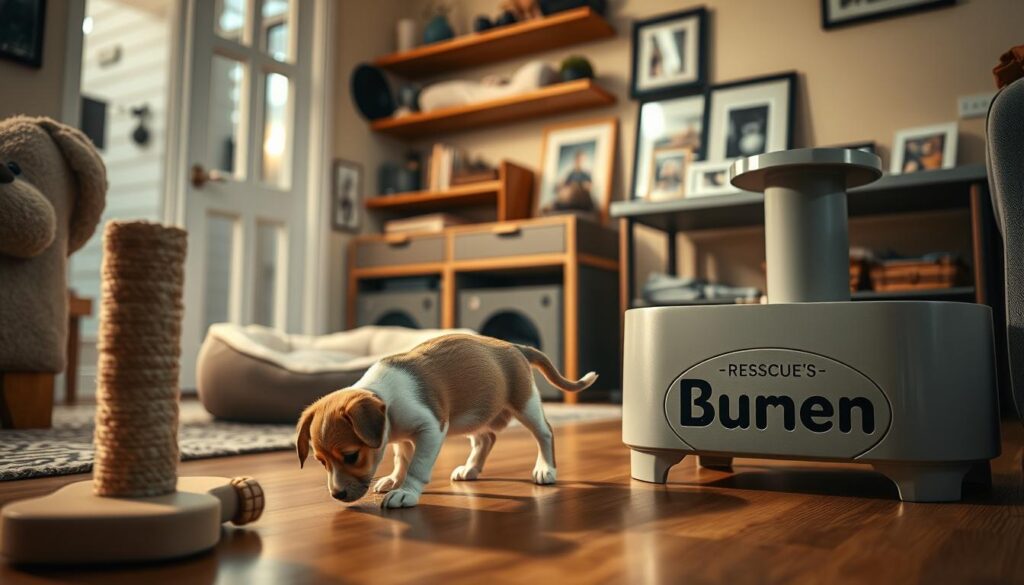
Housetraining Challenges
Even trained pets might act out again. Start by setting clear bathroom rules. Reward them with treats or praise when they do well.
Clean up accidents with special cleaners to remove smells. Keep a regular feeding schedule for predictability. Being consistent is key for adjusting to a new home.
Managing Separation Anxiety
Sudden loneliness can make pets clingy or destructive. Here’s how to tackle it:
- Start with short absences to build confidence
- Leave calming toys or familiar blankets
- Use puzzle feeders to keep them busy when you leave
- Never scold them for being anxious—reward calmness instead
Overcoming Resource Guarding
Resource guarding is a survival instinct. Try these methods:
- Trade toys or food calmly to show no threat
- Hand-feed meals to build trust
- Watch interactions until behavior gets better
Improvement takes time—housetraining might take weeks, while separation anxiety can take 2–4 weeks. Stay patient. These efforts will strengthen your bond and help your pet adjust.
Navigating Health Concerns for Rescue Animals
Welcoming rescue pets into your home means focusing on their health. Take them to the vet within the first week. This helps address any medical needs and supports their adjustment to their new home. Early care can prevent issues from getting worse.
Newly adopted pets often face health problems like respiratory infections and skin irritations. They might also have dental decay or parasites. If they were malnourished in the past, their recovery could be slower. Here’s how to act:
- Review medical records from shelters for vaccination history and existing conditions.
- Check for fleas, ear infections, or abnormal weight loss during daily routines.
- Follow vet recommendations for deworming, flea prevention, and booster shots.
Keep an eye on how they’re settling in by noting changes like:
- Appetite and bathroom habits
- Sleep patterns and energy levels
- Unusual behaviors like hiding or lethargy
Keep medical files from shelters up to date with new vet visits. Have a first-aid kit ready with essentials like antiseptic wipes and a thermometer. Find 24/7 emergency clinics nearby for urgent needs. Regular health care makes your new pet feel safe and healthy as they adjust.
Creating Long-Term Bonds Through Training and Play
Training and play are essential for your rescue pet’s happiness and security. This advice is for new pet owners. It focuses on fun activities that boost confidence and trust. Simple exercises help your pet adjust to their new home and strengthen your bond.
Basic Commands for Building Communication
Begin with simple commands to establish clear communication. Use positive rewards like treats or praise:
- Name Recognition: Say your pet’s name before giving food or playtime. Reward them when they look at you.
- Come: Practice in safe, familiar areas. Always reward with a treat or affection.
- Sit: Teach using a treat to guide them into position. Reward every success.
Interactive Games That Build Confidence
Choose games that match your pet’s personality:
- Dogs: Hide treats under bowls for scent hunts. Use a long leash for controlled outdoor exploration.
- Cats: Use feather wands to encourage play. Rotate toys to keep them interesting.
Using Enrichment Activities to Reduce Stress
Enrichment activities help reduce anxiety and redirect energy. Try:
- Food puzzles: Fill kongs with peanut butter or freeze-dried meat. This engages their natural foraging instincts.
- Sensory zones: Provide cardboard boxes for cats or digging areas for dogs to explore safely.
Consistent play and training build security. Small daily efforts lead to lasting trust. Celebrate every progress, no matter how small.
Embracing Your Journey as a Rescue Pet Parent
Welcoming a rescue pet into your home is a big step. Every day, you get to grow closer to them. It’s okay if it takes time to build trust or for them to feel calm during walks.
Adopted pets need time to adjust, and sometimes they might take a step back. Keeping a journal or photo log can help you see how far they’ve come. If you’re feeling unsure, look for support online or in local groups. They often have advice on common issues like housetraining and separation anxiety.
Connecting with other pet owners can make you feel less alone. Shelters like the ASPCA or Best Friends Animal Society have resources to help. Celebrate small victories, like a nap together or a curious sniff of a new toy. These moments help build trust.
This journey is as much for you as it is for your pet. By understanding their needs, you build a strong bond. The first weeks might be tough, but every step forward is a step towards a lifelong friendship. Your patience today will help create a strong foundation for your relationship.
